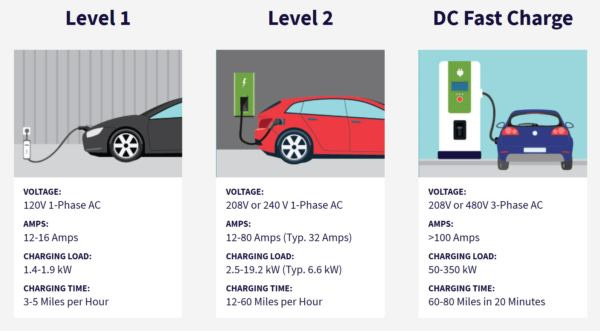
We are in a decade of Transportation Transformation. That's what Full Throttle explores. The newsletter will be delivered twice a week for free once you subscribe here. Follow me on Twitter, Instagram, and Linkedin.
If you read the last newsletter I hope you have a better idea of the differences between a BEV and a PHEV. Both of those electric vehicles (EVs) can be plugged into a charger. Ah, EV chargers, they are not all the same. There is a lot to understand about chargers and it involves a little bit of knowledge about electricity. Yikes!

(Credit: Stellantis)
kW- Kilowatt- Probably the most important term in the EV world. Simply, one kW is 1,000 watts. The measurement is used to define how fast a battery can be charged. It will also tell you the power of the motor in the EV. With some math you can convert the motor’s kWs to horsepower (kWs x 1.34).
kWh- Kilowatt-Hour- The official definition of kWh is the amount of energy used in one hour to power a 1,000 watt device. So, it would take 1- kWh to light up 10-100 watt bulbs for an hour. There’s some math involved with voltage and amperage to determine kWhs. I am not going there. But, kWh is important because it’s used to measure how much electricity a battery can store, its capacity (bigger usually means more range).
A video explainer of electricity for electric vehicles. (Credit: PGE)
EVSE- Electric Vehicle Service Equipment- You and I would just call this a charging station (it could be in your garage). They are popping up along interstates and in store parking lots. Many more are coming in the next couple of years.
CHARGING STATIONS

(Credit: AdvancedEnergy.org)
Level 1 Charging- This is plugging your car into a regular wall socket and using its alternating current (AC). It is the slowest way to charge. Your home outlets are 120 volts (up to about 2.4 kW). This will give your battery about 2-5 miles of charge for every hour. It will take more than a day to fully charge the latest generation of batteries on Level 1.
Level 2 Charging- This is a major upgrade for charging in your garage. Think about your clothes dryer and that three-pronged plug. That is a 240 volt line, which is used for Level 2 Charging (up to 19kW). A modern battery will be charged sufficiently, if not fully, overnight on a Level 2 system (10-20 miles per hour). Many of the public charging stations are also Level 2.

Rendering of the "charging station of the future." (Credit: Electrify America)
DCFC- Direct Current Fast Charging- This is often called Level 3 Charging (the term is being used so much it’s likely to be adopted officially in the future). These are fast chargers that are being built and operated by several companies around the country and use direct current (DC). Fast Chargers push out electricity at 480 volts (up to 350 kW). The latest generation battery can reach 80% charge in about 20-30 minutes. The charging companies are hoping to boost these stations to even higher outputs allowing a similar charge in 5-10 minutes (this is several years away).
Tesla has its own version of DCFC which it calls Supercharger. Tesla’s system has been for Tesla owners only. However, Elon Musk says he will open up his network to other vehicles. You will need an adapter to charge a non-Tesla vehicle because there isn’t a standard plug, yet.
THE PLUGS

Current EV charger plug types. (Credit: EV-GO)
CCS- Combined Charging System- This is like to become the standard charging plug. It’s officially called the SAE combo charger. It allows charging with AC or DC power. It’s being used in Europe and North America.
Tesla Plug- This is a proprietary plug for Tesla vehicles. Tesla is starting to provide CCS plugs at some of its charging stations.

Tesla's proprietary plug.
CHAdeMO- This is a plug that has been favored by some Japanese automakers. While it is likely to remain the standard in Japan, it may be used less in cars built for the US market. Many Japanese EVs are expected to be outfitted with the CCS plug.
SAE J1772- Known as the “J plug,” it is used for Level 2 charging and is part of the CCS plug.

MPGe sample label. (Credit: EPA)
MPGe- Miles Per Gallon Equivalent- The Environmental Protection Agency has come up with this measurement to compare the amount of electricity needed to match the energy in a gallon of gasoline. It’s very useful in comparing the performance among EVs.
It’s a lot to take in. If you want an EV with a bit of horsepower look for a motor with a high kW number. You will then need a battery with a high kWh number to feed that motor. The car will likely have a CCS plug which will allow you to take advantage of the DCFC stations, a charge that will come with a charge. The Level 2 charger in your garage is likely to take care of most of your needs. Got it?
(Cover image credit: Getty Images)




